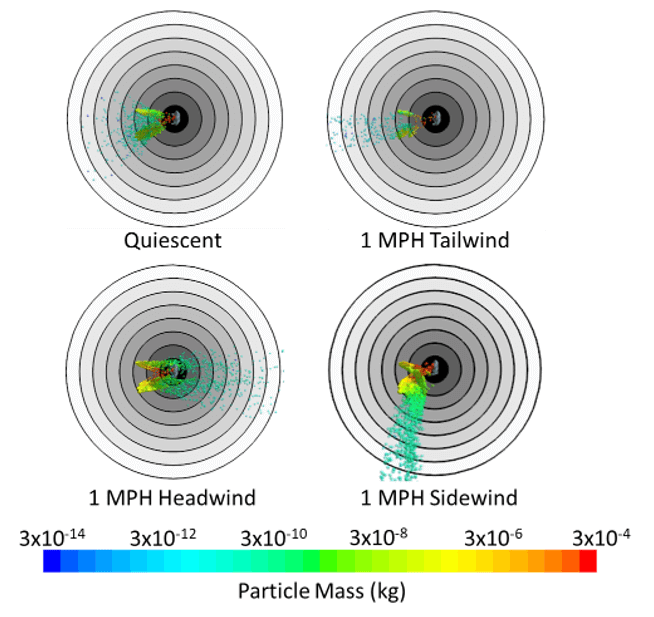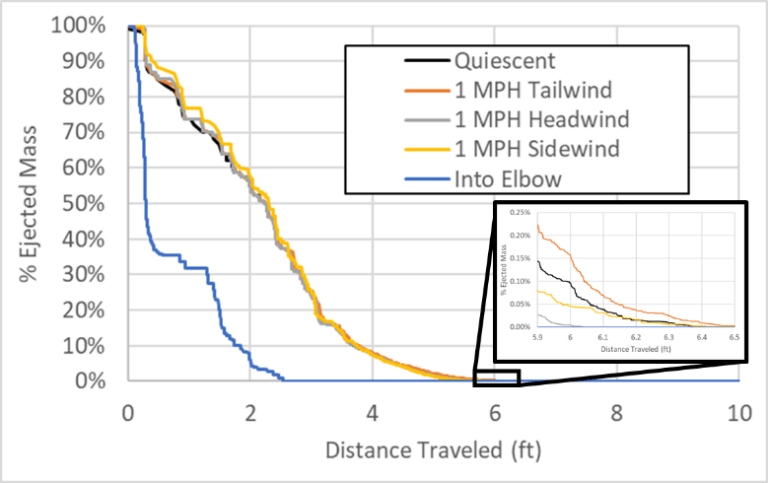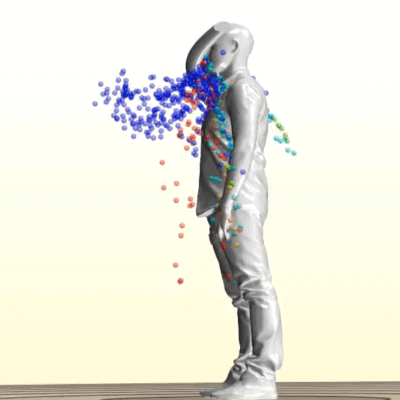The rich collection of physics models in STAR-CCM+ make this software well suited to simulating a wide variety of problems in disciplines ranging from aerospace engineering to infectious disease epidemiology. For example, ATA Engineering recently used STAR-CCM+ to demonstrate how advanced modeling techniques could be utilized to predict mucus distribution patterns resulting from a sneeze from a person’s nose. The following is a quick demonstration of how STAR-CCM+ could help to substantiate health guidelines for safe social distancing. The purpose of this work was to demonstrate the software’s modeling and postprocessing capabilities; as these results have not been validated against data and have not been subjected to a peer-review process, they should not be construed as providing scientific recommendations or guidelines.

The airflow was modeled as an ideal gas and simulated using the Eulerian Segregated Solver, while mucus droplets were modeled as liquid particles using the Lagrangian Multiphase Model with the properties of water. The sneeze was modeled as a 0.5 second duration [1], 100 MPH airflow [2] from the nostrils of a 5′8″ human geometry. The mucus particles were released at the nostril opening in a lognormal distribution with a mean diameter of 360.1 µm [1] and a geometrical standard deviation of 1.5, with a minimum size of 125 nm (the size of a typical virus [3]) and a maximum size of 1 cm (roughly the diameter of a nostril).
The sneeze simulation was run for four different environmental conditions: quiescent flow, 1 MPH tailwind, 1 MPH headwind, and 1 MPH sidewind. The resulting scatter, depicted in Figure 1, shows that the most massive particles fall close to the source, but lighter particles can be carried long distances.

A fifth simulation was run in which the human model was modified so that the man was sneezing into his bent elbow, held 1.5 cm in front of his nose. The elbow was conservatively modeled so that the particles would reflect off the surface instead of sticking, as they would to other solid surfaces including the sneezer’s shirt.
The mass distributions in terms of distance from the surface are shown in Figure 2. Consistent with current recommendations from the Centers for Disease Control and Prevention (CDC), the model showed that all unblocked sneezes distributed the majority of their mass within 6 feet—99.9% in all cases except for the tailwind simulation, in which 95.3% of the mass was contained within a 6 foot radius. In the elbow-blocked case, nearly 100% of the mass fell within 6 feet, with 99.7% falling within 2 feet 7 inches of the source. In all cases, very small particles reached between 11 and 32 feet, depending on the winds.
These results support the CDC recommendation that the chance of transmission is significantly reduced if a minimum distance of 6 feet is kept between people; however, depending on local convection currents, small particles can travel farther. It was also found that sneezing into one’s elbow can significantly reduce the distribution distance of much of the sneezed mass; however, this resulted in vastly more mucus deposited on the shirt of the sneezer and still resulted in some small particles being suspended in air and capable of achieving much larger distances. Although the majority of the mass is contained within 6 feet, the public should be aware that small particles can travel farther and that social distance should be maximized when possible [4].
In summary, STAR-CCM+ is well suited to solving a wide range of fluid-flow problems, including the dispersion of solids and/or liquids suspended in a flow. ATA Engineering has qualified engineers ready to assist you with this or any other challenging fluid-flow problem you may have.
References:
- Han, Z.Y., W.G. Weng, and Q.Y. Huang. “Characterizations of Particle Size Distribution of the Droplets Exhaled by Sneeze.” Journal of The Royal Society Interface 10.88 (2013): 20130560.
- WebMD. “11 Surprising Sneezing Facts.” https://www.webmd.com/allergies/features/11-surprising-sneezing-facts#1
- Fehr, A.R., and S. Perlman. “Coronaviruses: An overview of their replication and pathogenesis.” Coronaviruses. Humana Press, New York, NY, 2015. 1-23.
- Tziperman Lotan, G. “Six-Foot Rule to Protect Against Coronavirus Is Questionable, MIT Professor Says.” Boston Globe, March 31, 2020.

